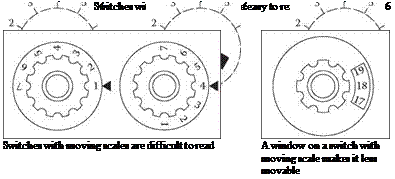These can be divided into two categories: cylindrical and winged. The primary difference between these is that the winged version has a pair of ‘wings’ above the cylindrical part. The wings function both as a positional marker and as a finger grip. Rotary switches may have from three to twenty-four different positions. They require a relatively large amount of space because the whole hand has to have room to turn around the switch. Where multiple position switches are used, these take up less space than the number of push-buttons or toggle switches required to fulfil the same function. Rotary switches can either have a fixed scale and moving pointer or a moving scale and fixed pointer. A variant on the moving scale is to have a window that only shows a small part of the scale. Various models are shown in Figure 5.3.
The following recommendations apply to rotary switches:
1. In most applications, rotary switches should have a fixed scale and a moving pointer.
2. There should be a detent in every position.
3. The turning resistance should steadily increase and then suddenly decrease as the next position is approached.
4. Cylindrical switches (knobs) should not be used if the resistance has to be high. In these cases, wing knobs are preferable.
5. Where only a few positions (two to five) are needed, they should be separated by 30 to 40 degrees.
 |
FIGURE 5.3 Design factors for rotary switches.
6. Where fewer than twenty-four positions are used, the beginning and end of the scale should be separated by a greater amount than between the different positions.
7. Where the workplace has low lighting levels, a sound should be made to denote that the switch has been activated. In these cases there should also be a definite stop position at the beginning of the scale, so that the positions can be counted out.
8. The scale should always increase clockwise.
9. The scale should not be shielded by the hand.
10. The surface of the switch should have a high coefficient of friction so that the hand does not slip.
11. The distance between panel and knob should be at least 3 mm.
12. The maximum amount of slope on the sides of the knob should be 5 degrees.



